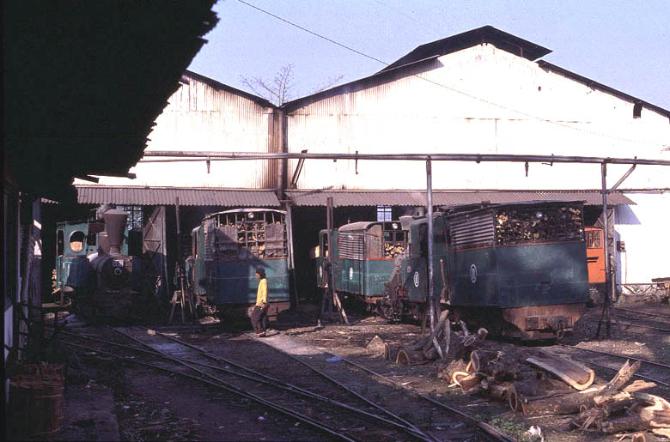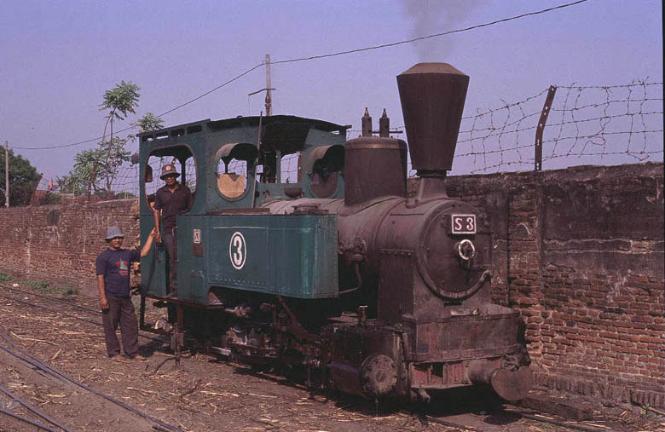| STEAM IN JAVA 2 All of the photographs on this section of the site were taken during a solo trip to Java in August 2004. Following Rob Dickinson's advice, I took a circuitous route from Tersana Baru mill in the west to Olean mill in the east. From there I retraced my steps back along the north coast and, after the obligatory visit to Mount Bromo, went south-west to Kediri and looped round via Mojokerto to Surabaya from where I caught an internal flight back to Jakarta. Full details of the journey are in my trip report. However in order to provide some clarity to these pages the mills are shown in west - east order using the mill numbering system adopted by Rob Dickinson. |
| Sumberharjo (10) Sumberharjo mill lies between Tegal and Pekalongan, close to the city of Pemalang. This 700mm gauge mill had six locomotives in steam on the day of my visit. Most of the steam working involves shunting wagons in the main yard but there is some field activity, with one engine taking out an ash train and another hauling a long rake of empty loris out to the cane fields. Left - Early morning scene at Sumberharjo shed with six locos being prepared for the day's activities. A number of derelict locomotives are also contained inside the shed |
| Orenstein and Coppel 0-8-0T No.3 (built 1912) stands at the top end of the main yard close to the weighbridge. Locomotives at Sumberharjo use bagasse as their principal fuel. |
| Du Croo and Brauns 0-8-0T No.9 (built 1925) begins its days work in the main yard at Sumberharjo. The large wicker basket on top of the side tank is used for loading bundles of bagasse onto the wagon immediately behind the engine. (10 August 2004) |

| O&K No.3 is seen leaving the mill area at Sumberharjo taking ash wagons (and a number of workers) to the fields. The ash comes from the boilers inside the sugar mill which themselves use bagasse as a fuel. |
| Sragi (11) I arrived at Sragi a year too late! Until 2004 this was one of the few remaining mills to use steam locomotives to bring in cane from the fields. However this has now finished with the work being handled by a small fleet of diesel locomotives. The remaining steam locomotives are used exclusively to propel rakes of loaded loris from the road delivery yard into the mill, which somewhat limits photographic opportunities. Once the engines have delivered their wagons they use an 'avoiding line' through the weighbridge to return to the head of the yard. Lines of empty wagons are also shunted into place ready to be loaded. One engine alone however makes this an unmissable location. Krauss 0-4-2 No.1 has recently been returned to working order after some years out of use - remarkably this engine was built in 1899 and has therefore had an active life spanning three centuries! |

| Hartmann 0-8-0T No.12 (built 1912) stands at the mill end of the road delivery yard ready to propel wagons into the mill. The mill lines at Sragi are all built to 600mm gauge. |
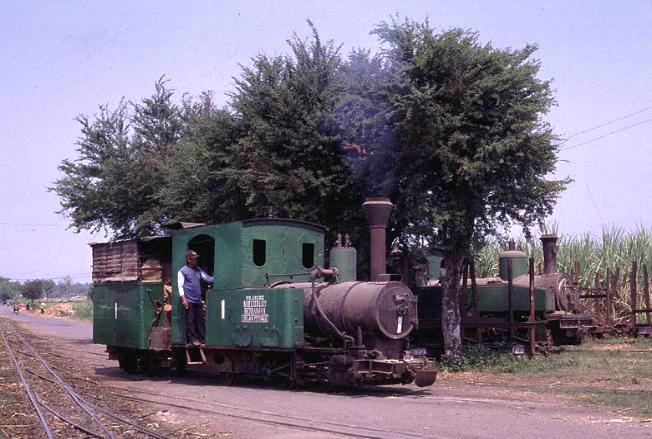
| Sragi's remarkable survivor - Krauss 0-4-2T No.1 runs around at the top end of the road delivery yard with Henschel 0-4-0T No.10 (built 1912) standing in the background) Update - this locomotive has now been purchased and moved to the United Kingdom for preservation |

| The figure in the foreground demonstrates the diminutive size of Henschel 0-4-0 No.10 as it returns from the mill to the top end of the yard (8 August 2004) |

| In complete contrast is BMAG 0-10-0T No.7 (built 1928) seen taking the 'avoiding line' back to the head of the yard. Hartmann 0-8-0T No.16 (also built 1912) was also at work on 8th August 2004 |
| Tasik Madu (18) Tasik Madu is a 750mm gauge mill located to the east of Solo. Like other mills the steam operation is limited to moving loaded cane wagons from the road delivery yard to the main mill yard. However the two yards are about 400 metres apart and the journey involves the trains coming right through the village, providing an opportunity to photograph some real 'street running'. The other reason to visit Tasik Madu is to see the Orenstein and Koppel 0-10-0.No.VI. This locomotive uses the Luttermoller system of articulation allowing it to negotiate tight curves. . Whilst normally referred to as an 0-10-0 in fact the leading and end driving wheels are not connected to the centre drivers by means of coupling rods but instead a geared system is used to transmit the power. There are several other Luttermollers at work in Java but none of the others have the same outline as No.VI. It is truly is a magnificent beast and made the long journey entirely worthwhile. Although I only spent an afternoon at Tasik Madu it is a mill that would certainly benefit from a full day or more on the lineside to get all the shots in the best light. |

| 'The Beast Of Tasik Madu' - the outline of the locomotive gives it the appearance of a much larger standard gauge locomotive yet it articulated axles allow it to successfully negotiate the sharp curves of this 750mm gauge line. Riding the footplate of this engine was a memorable experience as it made its way back to the mill |

| The angle of the afternoon sun made it difficult to photograph the locomotives working in the main mill yard. As well as O&K 0-8-0T No.5B the other yard locomotive was O&K 0-8-0T No.III |
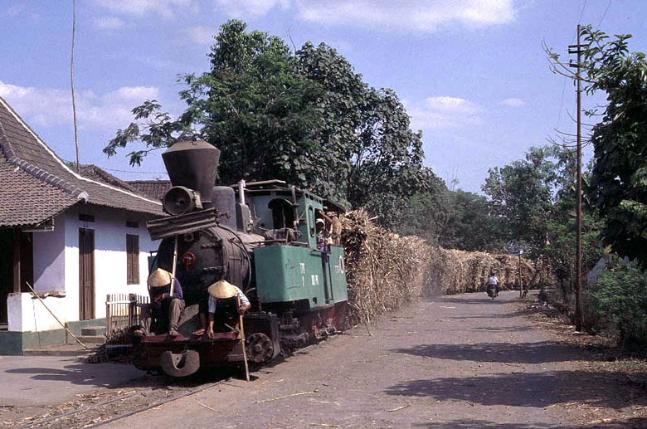
| The self-same afternoon light however then provided perfect illumination as Orenstein & Koppel 0-8-0T No.V brought a long train of loaded wagons through the village street on its way to the main mill yard. The usual method of hand sanding is in use as the two straw hatted gentlemen on the front buffer beam seek to prevent the engine slipping to a standstill. |
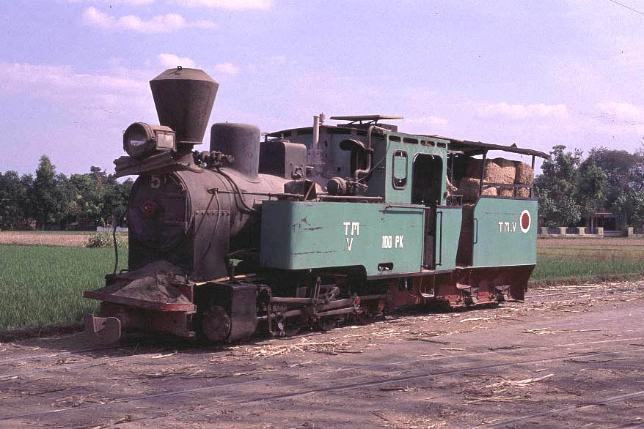
| Journey over and O&K 0-8-0 No.V pauses outside the mill gates before getting ready to return to the road delivery yard to collect another loaded train. During the afternoon a total of six trains progressed up the village street. |
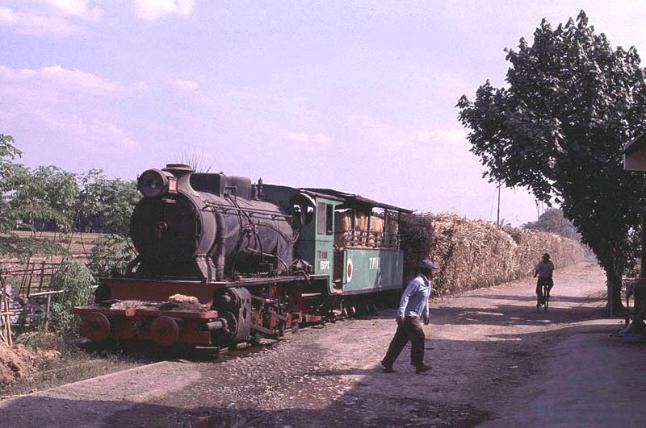
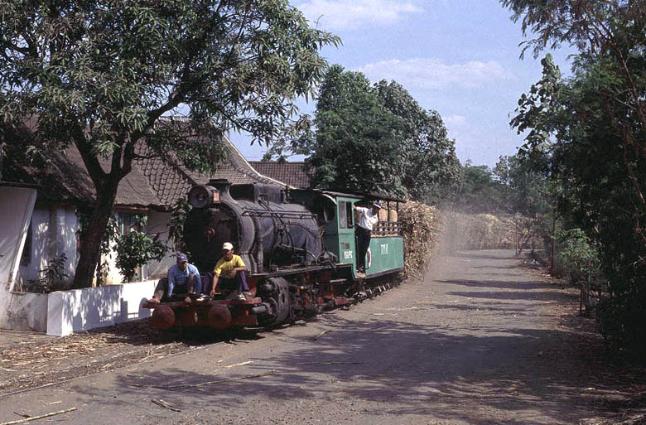
| Two more views of 'The Beast' as it works trains at Tasik Madumill. Once it has passed through the village the train runs onto a long headshunt where it stops and then slowly propels the train back through the mill gates (right) Street running at its absolute best as 'The Beast' brings a long train of loaded loris up through the village. Once again the hand sanders perch perilously on the front buffer beam to ensure that the loco maintains its footing (below) |
| USE THE BUTTONS BELOW TO EXPLORE THE REST OF THIS SITE |
